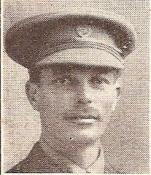
|
The King's School Canterbury |
Roll of Honour |
| Captain Cecil Herbert Wyndham BODINGTON | |
|
No 4 Company, Household Battalion Date of birth: 20th January 1880 Date of death: 11th April 1917 Killed in action aged 37 Commemorated on the Arras Memorial Bay1 |

|
| He was born at the Rectory at Suffield in Norfolk on the 20th of January 1880 the second son of the Reverend Herbert James Bodington, Vicar of Upton Grey, and Louisa Augusta (nee Mares-Cecil) of The Vicarage, Upton Grey, Winchfield in Hampshire. He was christened at Suffield on the 22nd of February 1880. He was educated as a boarder at the National School at Overstrand near Cromer in Norfolk and at Charterhouse School where he was in Saunderites House from September 1893 to December 1895 where he was a Junior Scholar. He went on to the King's School Canterbury from January 1896 to 1899, having gained a Junior Scholarship in December 1895. He gained a Senior Scholarship in July 1897 and was appointed as a School Monitor in September 1897. He played First XV Rugby in 1897 and 1898, was in the Fives Pair in 1897 and 1898, and played First XI Cricket from 1896 to 1899, being Captain for his last two years. After King's he was admitted to Peterhouse Cambridge on the 4th of December 1898 on an Open Classical Scholarship and attended from the 2nd of October 1899. He represented the college at cricket. He also represented the Cambridge Freshmen in 1900 and played varsity cricket in 1901 and 1902. Having achieved a Third Class Tripos Part 1 in 1902, he left university and, after a short time in the Cape, he became the tutor to the three children of the Maharaja Kapurthala for two years. On his return he became an assistant schoolmaster at Elstree and Stanmore Park Preparatory Schools in 1908. He continued to play cricket playing 10 matches for Hampshire in 1901 and 1902 as a right handed batsman, achieving a batting average of 11 with a highest score of 36. He also took 9 wickets in his first class career. After joining the army he played for the Household Brigade XI. He applied for a commission in the Royal Horse Guards on the 6th of November 1914. He had undergone a medical examination at Regents Park Barracks the previous day at which he had been passed as for for general service. He was commissioned as a 2nd Lieutenant in the regiment on the 10th of November 1914, joining their reserve. He was married to Lillias Emily May (nee Somerville) at St Peter's Church, Bayswater on the 25th of July 1916 and they lived at 49 Holland Park, Kensington W11. On the 9th of September 1916 he was promoted directly to Captain and posted to the newly formed Household Battalion. The Household Battalion was formed on September 1st 1916 from a surplus of men who had joined the Household Cavalry and were formed into an infantry battalion. Cecil Bodington was transferred from the Royal Horse Guards and was given command of Number 4 Company. The Battalion arrived in France on the 8th and 9th of November 1916. On the 2nd of February 1917 Captain Bodington was admitted to hospital. On the 9th of April 1917 the Battle of Arras began and the Household Battalion was ordered to attack on the 11th of April in support of the 2nd Battalion Seaforth Highlanders at Roeux. The Seaforths advanced at noon having endured a German artillery barrage while waiting to go over the top after they had been spotted by a German aircraft. Ten minutes later the Household Battalion followed them with Number 4 Company on the left of the battalion. As they advanced from the Hyderabad Redoubt Cecil Bodington was killed by machine gun fire and the two leading platoons of his company were "practically destroyed". The attack faltered as the other companies suffered terrible casualties. Number 3 Company under Captain Pelly gained some ground and he was ordered to consolidate this but otherwise the attack was a failure. Casualties were three officers and thirty six other ranks killed with one officer and one hundred and twenty four other ranks wounded and six missing. He is commemorated on the war memorial at Upton Grey, on the memorial at Charterhouse School and on the memorial at Peterhouse, Cambridge. |
|
Back